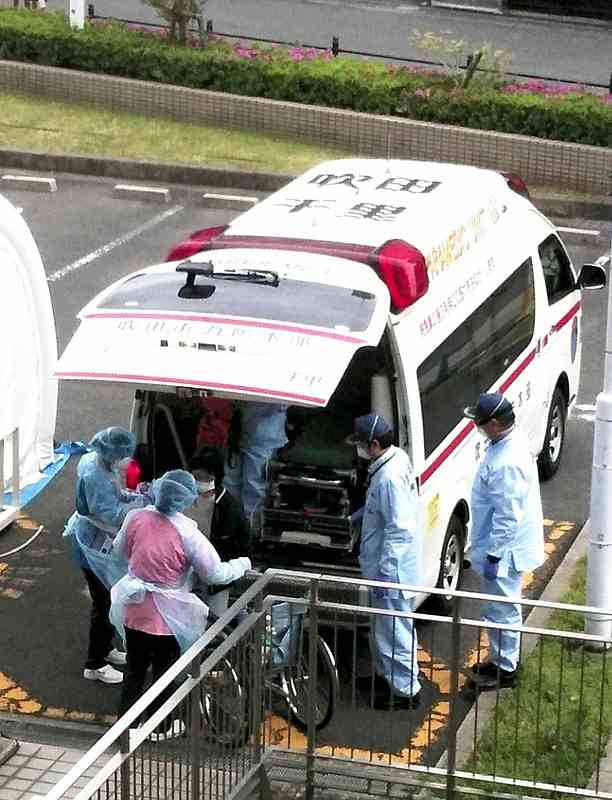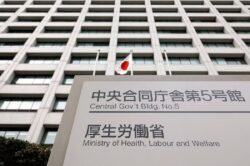
An ambulance is seen on Monday at Osaka City Juso Hospital, which accepts COVID-19 patients every day.
16:00 JST, April 17, 2021
The spread of novel coronavirus variants is threatening to overwhelm hospital bed capacity.
The so-called British variant, believed to be especially infectious, is prevalent at a time when Osaka Prefecture’s number of patients newly infected with all types of coronavirus has topped 1,200 a day. The variant causes COVID-19 symptoms to worsen more quickly than the original coronavirus strain, thereby filling hospital beds at a rapid pace. The variant has now begun spreading nationwide.
Crisis in Osaka
“We can’t find hospitals we can transfer our patients to, even if their symptoms become serious,” Osaka City Juso Hospital Director Yukio Nishiguchi said.
As an institute that is designated to treat COVID-19 patients, his hospital accepts patients with moderate symptoms. The number of patients who should be transferred to hospitals for those in serious condition due to poor respiratory function has been increasing day by day, from six on Tuesday to 18 on Thursday, and 60 of the hospital’s 70 beds have been occupied.
“The situation is different from up to the third wave,” Nishiguchi said.
The number of seriously ill patients in Osaka Prefecture had reached 261 as of Thursday. The prefecture had secured 241 beds for patients with severe symptoms, meaning its occupancy rate exceeded 100%. Of the seriously ill patients, 35 have been treated in beds for patients with mild symptoms.
In the wake of the crisis, the Osaka prefectural government has asked about 60 major hospitals in the prefecture to postpone nonessential hospitalizations and operations. In response, some hospitals have partially restricted their emergency response.
“We’re in an extremely difficult situation,” Osaka Gov. Hirofumi Yoshimura said. “We aim to secure 300 beds for patients with severe symptoms.”
Medical institutions are trying to meet this request. Osaka City General Hospital had already dedicated 20 of its 28 intensive care unit beds to coronavirus cases, and has now increased that to 23.
“We’ve suspended other emergency treatment and surgeries. We cannot do any more than that,” said Michinori Shirano, deputy chief at the hospital’s infectious diseases department. “The number of elderly people who will die without ventilators may increase.”
British variant
A rapid surge of the British variant is behind a rapid increase in hospital bed occupancy. In Osaka Prefecture, 82.8% of randomly selected COVID-19 samples from April 9 to 11 were found to be variants.
The problem with the British variant is that it causes severe symptoms at a higher rate than the other variants, and patients’ conditions worsen more quickly.
According to the prefecture’s analysis, 4.9% of patients with the coronavirus variants end up becoming severely ill, a rate 1.5 times higher than that seen during the third wave in this winter. Also, the worsening of symptoms after onset comes 1.5 days faster. As a result, the number of seriously ill patients in the prefecture has increased three times more rapidly than during the previous spread.
In the current surge, the symptoms are getting worse also among relatively younger people. Nearly 40% of seriously ill patients are aged less than 50. The proportion of newly infected people aged under 20 is 19%, about twice that of the third wave.
“In some cases, young people with no chronic disease suddenly become seriously ill,” said Rumiko Asada, who heads the prefecture’s follow-up center that is coordinating the hospitalization of more than 100 infected patients a day.
Eastern Japan, too
The threat of the British variant is not limited to the Kansai region.
A random sampling test conducted by the Tokyo metropolitan government found the proportion of variants rose from about 3% in late March to about 28% in the week ending April 11. This proportion is about 34% in Kanagawa Prefecture, which borders Tokyo to the south, and about 45% in Aichi Prefecture.
The spread of the British variant may prevent the containment of the coronavirus even if vaccination efforts advance.
University of Tsukuba Prof. Setsuya Kurahashi, who specializes in artificial intelligence, said Tokyo could see 3,900 people infected each day in October even if the government takes measures equivalent to a state of emergency every time Tokyo’s daily number of newly infected patients reaches 1,000.
Tohoku Medical and Pharmaceutical University Prof. Mitsuo Kaku said Thursday at a virus monitoring meeting in Tokyo, “This variant is a threat we must handle very carefully.”
“Thorough preventive measures must be taken, while medical supplies should be improved before the number of patients increases like in Osaka,” he said.
Efforts to increase beds
Local governments suffering a rapid increase in the number of COVID-19 patients are busy securing hospital beds.
On Thursday, Nara Prefecture became the first local government in the nation to request private hospitals to accept infected people under the revised infectious diseases law, which gives more authority to governors.
On April 9, the Hyogo prefectural government changed its policy of hospitalizing infected people in principle and allowed them to recuperate at home instead. The number of beds secured for the disease is currently 839, but the local government hopes to provide about 100 more beds this month.
Such efforts are seen in the Tokyo metropolitan area, too.
The Kanagawa prefectural government has fine-tuned its plan so that it now aims secure up to 1,790 beds, while classifying the condition of infections into five levels.
Before the revision, it aimed to secure up to 1,939 beds, but some hospitals were unable to accept patients as planned due to a shortage of nurses.
In Tokyo, the metropolitan government asked medical institutions to increase the number of beds for COVID-19 patients by about 1,000 to 6,044 earlier this month.
"Society" POPULAR ARTICLE
-

M4.9 Earthquake Hits Tokyo, Neighboring Prefectures
-

Israeli Tourists Refused Accommodation at Hotel in Japan’s Nagano Pref., Prompting Protest by Israeli Embassy and Probe by Prefecture
-

M7.5 Earthquake Hits Northern Japan; Tsunami Waves Observed in Hokkaido, Aomori and Iwate Prefectures
-

Tsukiji Market Urges Tourists to Avoid Visiting in Year-End
-

High School in Kyoto Says Students Shoplifted during Recent School Trip to Bali, Indonesia
JN ACCESS RANKING
-

Tokyo Economic Security Forum to Hold Inaugural Meeting Amid Tense Global Environment
-

Keidanren Chairman Yoshinobu Tsutsui Visits Kashiwazaki-Kariwa Nuclear Power Plant; Inspects New Emergency Safety System
-

Imports of Rare Earths from China Facing Delays, May Be Caused by Deterioration of Japan-China Relations
-

University of Tokyo Professor Discusses Japanese Economic Security in Interview Ahead of Forum
-

Japan Pulls out of Vietnam Nuclear Project, Complicating Hanoi’s Power Plans



























